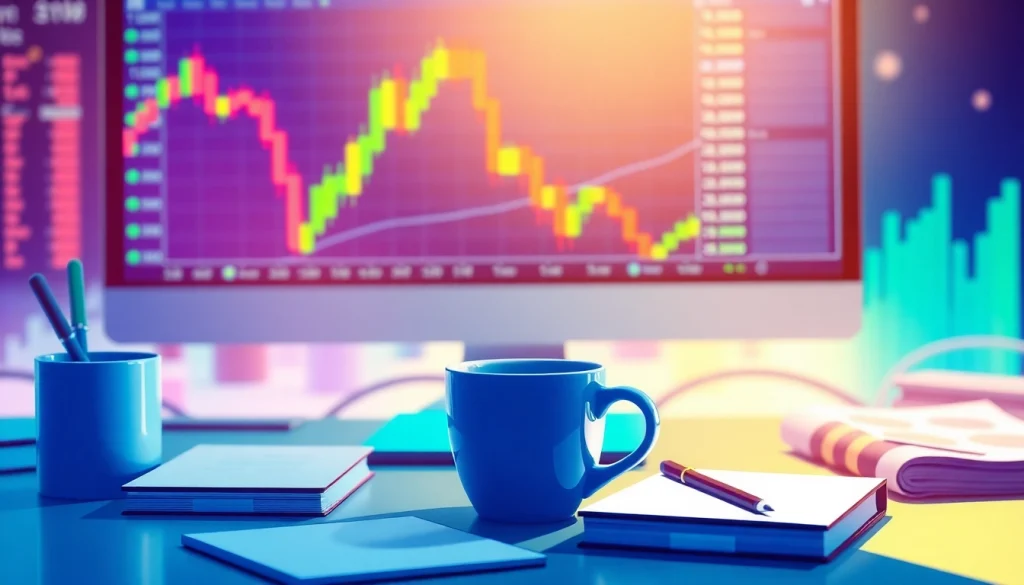
Understanding Forex Trading Basics
Forex trading, also known as foreign exchange trading, is a decentralized market where currencies are exchanged. It is the largest and most liquid market in the world, with a daily trading volume exceeding $6 trillion. This remarkable figure highlights the significance of forex trading in the global economy. For those interested in delving deeper into the dynamics of forex trading, understanding the core concepts is essential.
The Fundamentals of Forex Market
The forex market operates over-the-counter (OTC), meaning transactions occur directly between parties, usually through electronic trading platforms or networks. Unlike stock markets, there is no centralized exchange for forex, allowing trading to occur 24 hours a day, five days a week. The forex market’s primary function is to facilitate international trade and investment by providing a platform for currency conversion.
Currency pairs are the foundation of forex trading, where one currency is quoted against another. The most commonly traded pairs include major currencies such as EUR/USD, USD/JPY, and GBP/USD. Each currency pair has a base currency (the first currency listed) and a quote currency (the second currency listed). Understanding how to read these pairs is crucial for effective trading.
How to Start Forex Trading
Starting in forex trading involves a few steps, including setting up a trading account, choosing a reliable broker, and developing a trading strategy. Here are the essential steps to get started:
- Choose a Forex Broker: Research and select a broker that fits your trading requirements, including account types, fees, and trading platforms.
- Create a Trading Account: Open a demo account to practice trading without risking real money before moving on to a real account.
- Learn Trading Skills: Invest time in learning about forex market dynamics, technical analysis, fundamental analysis, and risk management strategies.
- Develop a Trading Plan: Outline your trading goals, risk tolerance, and strategies to help maintain discipline in your trading activities.
Key Terminology in Forex Trading
Understanding the terminologies used in forex trading is fundamental. Here are some key terms every trader should know:
- Pips: The smallest price movement in a currency pair, typically the fourth decimal place in most pairs.
- Spread: The difference between the bid price and ask price of a currency pair.
- Leverage: A mechanism that allows traders to control larger positions with a smaller amount of capital.
- Lot: A standard unit of measurement used to quantify the amount of currency in a trade.
- Margin: The amount of capital required to open a position, expressed as a percentage of the total trade value.
Core Strategies for Effective Forex Trading
Technical Analysis in Forex Trading
Technical analysis involves analyzing price movements and chart patterns to forecast future price actions. Traders use various tools and indicators, including:
- Trend Lines: Straight lines drawn on charts to connect price points and identify the direction of price movement.
- Moving Averages: Indicators that smooth out price data to identify trends over specific periods.
- Relative Strength Index (RSI): A momentum oscillator that measures the speed and change of price movements, helping traders identify overbought or oversold conditions.
- Fibonacci Retracement: A tool that helps traders identify potential areas of support or resistance based on the Fibonacci sequence.
Effective technical analysis combines the use of these tools to make informed trading decisions that can increase the chances of success.
Fundamental Analysis Explained
While technical analysis focuses on price action, fundamental analysis examines the economic, social, and political factors that influence currency values. Key elements include:
- Economic Indicators: Reports such as GDP, unemployment rates, and inflation rates provide insights into a country’s economic health.
- Central Bank Policies: Decisions made by central banks regarding interest rates and monetary policy have a major impact on currency strength.
- Geopolitical Events: Political stability, natural disasters, and economic sanctions can significantly affect market perceptions and currency values.
Combining both technical and fundamental analysis can provide a comprehensive view that enhances trading effectiveness.
Developing Your Trading Plan
A well-structured trading plan is crucial for success in forex trading. It should include:
- Trading Goals: Define specific, measurable, achievable, relevant, and time-bound (SMART) goals.
- Risk Management Strategies: Determine how much of your capital you are willing to risk on each trade and set stop-loss orders accordingly.
- Trading Methods: Clearly outline the methods you will use for entering and exiting trades, including which indicators or data points will trigger these actions.
- Review Process: Regularly assess your trading performance to identify successes and areas for improvement.
Risk Management in Forex Trading
Understanding Leverage and Margin
Leverage is a powerful tool in forex trading that allows traders to control larger positions with a smaller amount of capital. However, it also increases the risk of incurring substantial losses. Understanding how margin and leverage work is essential. The margin is the amount of capital required to open a leveraged position, and it is expressed as a percentage.
For example, if a broker offers a leverage ratio of 100:1, a trader would need to invest only 1% of the total trade value as margin. While high leverage can amplify profits, it can equally lead to significant losses, making risk management a key component of successful trading.
Setting Stop-Loss and Take-Profit Orders
Stop-loss and take-profit orders are essential tools for risk management in forex trading. A stop-loss order automatically closes a position when a specified price level is reached, limiting potential losses. Similarly, a take-profit order locks in profits when a trade reaches a predetermined target price.
By employing these orders strategically, traders can minimize emotional trading decisions and adhere to their trading plans, leading to more disciplined and consistent trading performance.
Using Risk-to-Reward Ratios Effectively
The risk-to-reward ratio is a critical metric that compares the potential profit of a trade against the potential loss. A common rule of thumb is to aim for a risk-to-reward ratio of at least 1:2, meaning that for every $1 risked, the potential reward should be at least $2.
Understanding and calculating risk-to-reward ratios can help traders make informed decisions and ensure their trading strategy is aligned with their risk tolerance and profit objectives.
Tools and Resources for Forex Traders
Technical Indicators Every Trader Should Know
In the realm of forex trading, technical indicators are invaluable tools that assist traders in analyzing market conditions and making informed decisions. Here are some essential indicators to consider:
- Bollinger Bands: This indicator measures market volatility and consists of a middle band (moving average) and two outer bands that represent standard deviations.
- MACD (Moving Average Convergence Divergence): A trend-following momentum indicator that shows the relationship between two moving averages of a security’s price.
- Stochastic Oscillator: A momentum indicator comparing a particular closing price of a commodity to a range of its prices over a certain period, indicating overbought or oversold conditions.
Best Online Platforms for Forex Trading
Selecting the right trading platform is crucial for executing trades effectively and efficiently. Some popular platforms include:
- MetaTrader 4 (MT4): A widely used platform with a user-friendly interface, comprehensive charting tools, and automated trading capabilities.
- MetaTrader 5 (MT5): The successor to MT4, offering more advanced features and additional asset classes to trade beyond forex.
- cTrader: Known for its intuitive design and advanced trading tools, cTrader is popular among forex traders who prefer a clean and efficient interface.
Utilizing Forex Trading Simulators
Forex trading simulators allow traders to practice in a risk-free environment. These tools provide a virtual trading experience, enabling users to familiarize themselves with trading platforms, test strategies, and refine their skills without financial risk. Here’s how to make the most of a trading simulator:
- Simulate Real Market Conditions: Utilize simulators that replicate real market conditions to experience genuine trading environments.
- Test Multiple Strategies: Experiment with various strategies to determine what works best for your trading style and goals.
- Review Performance Metrics: Analyze your trades and performance data to identify strengths and weaknesses in your trading approach.
Advanced Concepts in Forex Trading
Exploring Automated Forex Trading
Automated trading, or algorithmic trading, employs computer programs and algorithms to execute trades based on predefined criteria. This approach offers several advantages:
- Emotion-Free Trading: Automation eliminates emotional decision-making, allowing for strict adherence to trading strategies.
- Speed and Efficiency: Automated systems can execute trades in milliseconds, taking advantage of market fluctuations that manual traders may miss.
- Backtesting Capability: Traders can assess how strategies would have performed in past market conditions, enhancing the strategy’s reliability.
Understanding Trading Psychology
Trading psychology significantly impacts trading performance. Emotional factors like fear and greed can lead to irrational decision-making and deviating from established strategies. Some tips for managing emotions in trading include:
- Develop a Routine: Establishing a consistent trading routine can help maintain focus and discipline.
- Practice Mindfulness: Techniques such as meditation and visualization can improve mental clarity and reduce anxiety.
- Learn from Mistakes: Reflecting on past trades, both successful and unsuccessful, can provide insights into emotional responses and improve future performance.
Market Trends and Global Influences on Forex
The forex market is influenced by numerous external factors, including global economic trends, political events, and market sentiments. Keeping abreast of these influences can significantly enhance trading success:
- Economic Data Releases: Economic indicators, such as employment reports and inflation rates, often lead to volatility in currency values.
- Central Bank Announcements: Changes in interest rates and monetary policy decisions by central banks can create immediate impacts on currency prices.
- Global Events: Political instability, trade agreements, and other geopolitical developments can shift market sentiments dramatically.
By harnessing these advanced concepts and integrating them into their trading strategies, traders can better navigate the complexities of the forex market and improve their chances of success.



